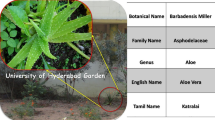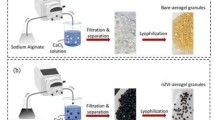Abstract
Present work reports the under pressure preparation of reduced gum rosin and acrylamide-based GrA-cl-poly(AAm) green flocculant. Characterization of the synthesized product was carried out by different techniques such as Fourier transform infrared spectroscopy, X-ray diffraction method and scanning electron microscopy. In addition, several variables such as time, physiological pH, solvent, pressure, monomer, cross-linking agent and initiator were examined to obtain maximum flocculation efficiency and explore the salt resistant swelling of the system. The maximum percentage swelling (P s) at pH 7.0 and pressure 8.0 psi was found to be 578 %. Thermal behavior of the flocculant was investigated and the synthesized sample showed higher thermal stability than the gum rosin. The effect of ionic strength and charges of various cations (Na+, Ba+2, Fe+3, Sn+4) on salt resistant swelling of GrA-cl-poly(AAm) flocculant, in different salt solutions such as sodium chloride, barium chloride, ferric chloride and stannic chloride (NaCl, BaCl2, FeCl3 and SnCl4), was also studied. The synthesized sample was found to show ionic charge and salt concentration related behavior. Further, the removal of colloidal particles from wastewater through flocculation showed that GrA-cl-poly(AAm) exhibited significant flocculation efficiency (95.18 %) at a dose rate of 55 mg at 30 °C and pH 5.0. Flocculant capacity in saline medium was found to be maximum (99 %) at 1 % concentration. Further, increase in saline concentration resulted in decreased flocculant capacity. The kinetics of the aggregation of particles, deflocculation and reflocculation was analyzed through the Smoluchowski classical model based on first-order and second-order kinetics.














Similar content being viewed by others
References
Marci G, Mele G, Palmisano L, Pulito P, Sannino A (2006) Environmentally sustainable production of cellulose-based superabsorbent hydrogels. Green Chem 8:439–444
Guilherme MR, Campese GM, Radovanovic E, Rubira AF, Feitosa JPA, Muniz EC (2005) Morphology and water affinity of superabsorbent hydrogels composed of methacrylated cashew gum and acrylamide with good mechanical properties. Polymer 46:7867–7873
Temtem M, Casimiro T, Mano JF, Aguiar-Ricardo A (2007) Green synthesis of a temperature sensitive hydrogel. Green Chem 9:75–79
Li P, Xu K, Tan Y, Lu C, Li Y, Wang P (2013) A novel fabrication method of temperature-responsive poly(acrylamide) composite hydrogel with high mechanical strength. Polymer 54:5830–5838
Candido JDS, Pereira AGB, Fajardo AR, Ricardo NMPS, Feitosa JPA, Muniz EC, Rodrigues FHA (2013) Poly(acrylamide-co-acrylate)/rice husk ash hydrogel composites. II. Temperature effect on rice husk ash obtention. Compos Part B 51:246–253
Kulkarni RV, Boppana R, Mohan GK, Mutalik S, Kalyane NV (2012) pH-responsive interpenetrating network hydrogel beads of poly(acrylamide)-g-carrageenan and sodium alginate for intestinal targeted drug delivery: synthesis, in vitro and in vivo evaluation. J Colloid Interf Sci 367:509–517
Ye G, Wang X (2010) Polymer diffraction gratings on stimuli-responsive hydrogel surfaces: soft-lithographic fabrication and optical sensing properties. Sensors Actuators: B: Chem 147:707–713
Mi P, Ju X, Xie R, Wu HG, Ma J, Chu LY (2010) A novel stimuli-responsive hydrogel for Kþ-induced controlled-release. Polymer 51:1648–1653
Guan T, Godts F, Ceyssens F, Vanderleyden E, Adesanya K, Dubruel P, Neves HP, Puers R (2012) Development and fabrication of a novel photopatternable electric responsive Pluronic hydrogel for MEMS applications. Sensors Actuators A: Phys 186:184–190
Liu Y, Servant A, Guy OJ, Al-Jamal KT, Williams PR, Hawkins KM, Kostarelos K (2011) An electric-field responsive microsystem for controllable miniaturised drug delivery applications. Proc Eng 25:984–987
Ozcelik B, Brown KD, Blencowe A, Daniell M, Stevens GW, Qiao GG (2013) Ultrathin chitosan–poly(ethylene glycol) hydrogel films for corneal tissue engineering. Acta Biomater 9:6594–6605
Saruchi Kaith BS, Jindal R, Kumar V, Bhatti MS (2014) Optimal response surface design of Gum tragacanth-based poly[acrylic acid-co-acrylamide] IPN hydrogel for the controlled release of the antihypertensive drug losartan potassium. RSC Adv 4:39822–39829
Wang WB, Huang DJ, Kang YR, Wang AQ (2013) One-step in situ fabrication of a granular semi-IPN hydrogel based on chitosan and gelatin for fast and efficient adsorption of Cu2+ ion. Colloid Surf B Biointerf 106:51–59
Kaith BS, Sharma R, Sharma K, Choudhary S, Kumar V, Lochab SP (2015) Effects of O7+ and Ni9+ swift heavy ions irradiation on polyacrylamide grafted Gum acacia thin film and sorption of methylene blue. Vacuum 111:73–82
Saruchi Kaith BS, Jindal R, Kumar V (2014) Synthesis, characterization and evaluation of Gum tragacanth and acrylic acid hydrogel for sustained calcium chloride release-enhancement of water holding capacity of soil. J Chin Adv Mater Soc 2:40–52
Saruchi Kaith BS, Jindal R, Kapur GS (2013) Enzyme-based green approach for the synthesis of gum tragacanth and acrylic acid cross-linked hydrogel: its utilization in controlled fertilizer release and enhancement of water-holding capacity of soil. Iran Polym J 22:561–570
Saruchi Kaith BS, Jindal R, Kumar V (2015) Biodegradation of Gum tragacanth acrylic acid based hydrogel and its impact on soil fertility. Polym Degrad Stab 115:24–31
Saruchi Kaith BS, Jindal R, Kumar V (2015) The adsorption of crude oil from an aqueous solution using a Gum tragacanth polyacrylic acid based hydrogel. Pet Sci Technol 33:278–286
Pan JR, Huang C, Chen S, Chung YC (1999) Evaluation of a modified chitosan biopolymer for coagulation of colloidal particles. Colloid Surf: A 147:359–364
Zhao YX, Wang Y, Gao BY, Shon HK, Kim JH, Yue QY (2012) Coagulation performance evaluation of sodium alginate used as coagulant aid with aluminum sulfate, iron chloride and titanium tetrachloride. Desalination 299:79–88
Mittal H, Mishra SB, Mishra AK, Kaith BS, Jindal R, Kalia S (2013) Preparation of poly(acrylamide-co-acrylic acid)-grafted gum and its flocculation and biodegradation studies. Carbohydr Polym 98:397–404
Abeer MM, Amin MCIM, Lazim AM, Pandey M, Martin C (2014) Synthesis of a novel acrylated abietic acid-g-bacterial cellulose hydrogel by gamma irradiation. Carbohydr Polym 110:505–512
Tan WX, Lin ZT, Bu HT, Tian Y, Jiang GB (2012) Nano-micelles based on a rosin derivative as potent sorbents and sinking agents with high absorption capabilities for the removal of metal ions. RSC Adv 2:7279–7289
Liu X, Xin W, Zhang J (2009) Rosin-based acid anhydrides as alternatives to petrochemical curing agents. Green Chem 11:1018–1025
Wang L, Shi Y, Wang Y, Zhang H, Zhou H, Wei Y, Ta S, Ma T (2014) Composite catalyst of rosin carbon/Fe3O4: highly efficient counter electrode for dye-sensitized solar cells. Chem Commun 50:1701–1703
Sharma K, Kaith BS, Kumar V, Kalia S, Kumar V, Swart HC (2014) Synthesis and biodegradation studies of gamma irradiated electrically conductive hydrogels. Polym Degrad Stab 107:166–177
Anastasakis K, Kalderis D, Diamadopoulos E (2009) Flocculation behavior of mallow and okra mucilage in treating wastewater. Desalination 249:786–791
Zheng Y, Yao K, Lee J, Chandler D, Wang J, Wang C, Chu F, Tang C (2010) Well-defined renewable polymers derived from Gum rosin. Macromolecules 43:5922–5924
Kaith BS, Jindal R, Sharma R (2015) Synthesis of a Gum rosin alcohol-poly(acrylamide) based adsorbent and its application in removal of malachite green dye from waste water. RSC Adv 5:43092–43104
Kaith BS, Sharma K, Kumar V, Kumar V, Swart HC, Kalia S (2014) Effects of swift heavy ion beam irradiation on the structural and morphological properties of poly(methacrylic acid) cross-linked gum ghatti films. Vacuum 101:166–170
Kaith BS, Sharma K, Kumar V, Kalia S, Swart HC (2014) Fabrication and characterization of gum ghatti-polymethacrylic acid based electrically conductive hydrogels. Synth Met 187:61–67
Saruchi Kaith BS, Jindal R (2014) Synthesis, characterization and evaluation of Gum tragacanth and acrylic acid based hydrogel for sustained calcium chloride release- enhancement of water holding capacity of soil. J Chin Adv Mater Soc 2:40–52
Kaith BS, Jindal R, Mittal H, Kumar K (2010) Temperature, pH and electric stimulus responsive hydrogels from Gum ghatti and polyacrylamide-synthesis, characterization and swelling studies. Der Chem Sin 1:44–54
Wang L, Shi Y, Wang Y, Zhang H, Zhou H, Wei Y, Tao S, Ma T (2014) Composite catalyst of rosin carbon/Fe3O4: highly efficient counter electrode for dye-sensitized solar cells. Chem Commun 50:1701–1703
Brostow W, Datashvili T, Geodakyan J, Lou J (2011) Thermal and mechanical properties of EPDM/PP+ thermal shock-resistant ceramic composites. J Mater Sci 46:2445–2455
Orozco VH, Brostow W, Chonkaew W, Lopez BL (2009) Preparation and characterization of poly(lactic acid)-g-maleic anhydride + starch blends. Macromol Symp 277:69–80
Das KK, Somasundaran P (2003) Flocculation-dispersion characteristics of alumina using a wide molecular weight range of polyacrylic acids. Colloid Surf: A 223:17–25
Ren H, Li Y, Zhang S, Wang J, Luan Z (2008) Flocculation of kaolin suspension with the adsorption of N, N-disubstituted hydrophobically modified polyacrylamide. Colloid Surf A Physicochem Eng Asp 317:388–393
Zeng D, Wu J, Kennedy JF (2008) Application of a chitosan flocculant to water treatment. Carbohydr Polym 71:135–139
Sasmal D, Singh RP, Tripathy T (2015) Synthesis and flocculation characteristics of a novel biodegradable flocculating agent amylopectin-g-poly(acrylamide-co-N-methylacrylamide). Colloid Surf A Physicochem Eng Asp 482:575–584
Mishra A, Srinivasan R, Bajpai M, Dubey R (2004) Use of polyacrylamide-grafted Plantago psyllium mucilage as a flocculant for treatment of textile wastewater. Colloid Polym Sci 282:722–727
Besra L, Sengupta DK, Roy SK, Ay P (2003) Influence of surfactants on flocculation and dewatering of kaolin suspensions by cationic polyacrylamide (PAM-C) flocculant. Sep Purif Technol 30:251–264
Besra L, Sengupta DK, Roy SK, Ay P (2002) Flocculation and dewatering of kaolin suspensions in the presence of polyacrylamide and surfactants. Int J Miner Process 66:203–232
Besra L, Sengupta DK, Roy SK, Ay P (2002) Studies on flocculation and dewatering of kaolin suspensions by anionic polyacrylamide flocculant in the presence of some surfactants. Int J Miner Process 66:1–28
Das R, Ghorai S, Pal S (2013) Flocculation characteristics of polyacrylamide grafted hydroxypropyl methyl cellulose: an efficient biodegradable flocculant. Chem Eng J 229:144–152
Chena Y, Liu S, Wang G (2007) A kinetic investigation of cationic starch adsorption and flocculation in kaolin suspension. Chem Eng J 133:325–333
Acknowledgments
Authors are highly thankful to MHRD for providing financial assistance to carry out our research work. Authors are also grateful to DST-FIST for providing financial assistance for the procurement of equipment used in the characterization of the samples.
Author information
Authors and Affiliations
Corresponding author
Rights and permissions
About this article
Cite this article
Kaith, B.S., Jindal, R. & Sharma, R. Study of ionic charge dependent salt resistant swelling behavior and removal of colloidal particles using reduced gum rosin-poly(acrylamide)-based green flocculant. Iran Polym J 25, 349–362 (2016). https://doi.org/10.1007/s13726-016-0427-7
Received:
Accepted:
Published:
Issue Date:
DOI: https://doi.org/10.1007/s13726-016-0427-7




